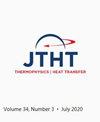Analytical Solution for One-Dimensional Transient Thermal Conduction in a Hollow Cylinder
IF 1.7
4区 工程技术
Q4 ENGINEERING, MECHANICAL
引用次数: 0
Abstract
The primary use of analytical solutions in the area of thermal conduction problems is for verification purposes, comparing the calculated temperatures and heat flux values to the results from numerical codes. The contribution from the analytical solutions can be especially significant where large temperature gradients are found. This is because the temperature and heat flux results can be found very precisely: normally to eight or 10 significant figures using analytical solutions. Normally, numerical solutions require extremely fine grids in high-heat-flux locations, but analytical solutions can provide insight into the adequacy of grid densities in these types of situations. One area of particular interest is in nonrectangular analytical solutions because generalized numerical grids do not naturally lend themselves well to curved surfaces without a large number of nodes. In this current study, four solutions are offered in a geometry involving a hollow cylinder. Two of the solutions examine heating from the inside of the cylinder, and two involve heating from the outside. Development of the solutions is provided along with results that show the temperature responses to the various sets of boundary conditions. A mathematical identity is used as part of the solution, which eliminates the need to evaluate an infinite series, along with need to find roots of transcendental equations and evaluate Bessel functions. Intrinsic verification is also applied in order to provide assurance that the solutions are properly formulated and evaluated.空心圆柱一维瞬态导热的解析解
分析解在热传导问题领域的主要用途是用于验证目的,将计算的温度和热通量值与数值代码的结果进行比较。在发现大的温度梯度的情况下,分析解的贡献可能特别显著。这是因为温度和热通量的结果可以非常精确地找到:通常使用解析解可以得到8或10个有效数字。通常,数值解需要在高热通量位置使用极细的网格,但分析解可以深入了解网格密度在这些情况下的充分性。一个特别感兴趣的领域是非矩形分析解,因为广义数值网格在没有大量节点的情况下自然不适合曲面。在当前的研究中,在涉及空心圆柱体的几何结构中提供了四种解决方案。其中两种解决方案检测从气缸内部加热,两种涉及从外部加热。提供了解的发展以及显示对各种边界条件的温度响应的结果。数学恒等式被用作解的一部分,这消除了对无限级数求值的需要,以及对超越方程的根和贝塞尔函数求值的需要。内部验证也被应用,以确保解决方案得到正确的制定和评估。
本文章由计算机程序翻译,如有差异,请以英文原文为准。
求助全文
约1分钟内获得全文
求助全文
来源期刊

Journal of Thermophysics and Heat Transfer
工程技术-工程:机械
CiteScore
3.50
自引率
19.00%
发文量
95
审稿时长
3 months
期刊介绍:
This Journal is devoted to the advancement of the science and technology of thermophysics and heat transfer through the dissemination of original research papers disclosing new technical knowledge and exploratory developments and applications based on new knowledge. The Journal publishes qualified papers that deal with the properties and mechanisms involved in thermal energy transfer and storage in gases, liquids, and solids or combinations thereof. These studies include aerothermodynamics; conductive, convective, radiative, and multiphase modes of heat transfer; micro- and nano-scale heat transfer; nonintrusive diagnostics; numerical and experimental techniques; plasma excitation and flow interactions; thermal systems; and thermophysical properties. Papers that review recent research developments in any of the prior topics are also solicited.
 求助内容:
求助内容: 应助结果提醒方式:
应助结果提醒方式:


